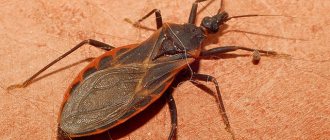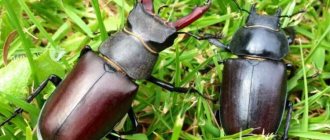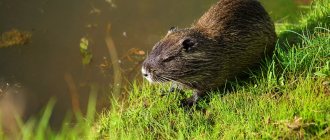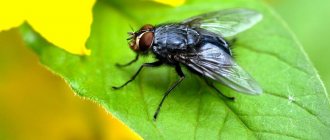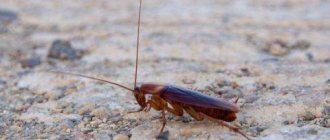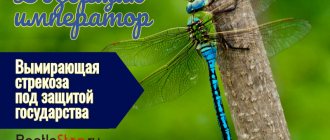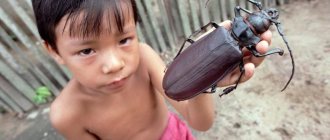Dragonfly squad
Anax imperator
A dragonfly belonging to the rocker family. It is considered one of the largest in Russia and belongs to a species whose numbers are declining. The length of the wings is up to 5 cm. The Emperor Watcher has a huge distribution area and is found in almost all natural areas. Prefers bodies of water. The average population density is 12 individuals per 100 m. The number of dragonflies is declining due to pollution of water bodies, unsuitable temperatures and natural competition.
Anax imperator
Order Orthoptera
Steppe racket (Saga pedo)
A grasshopper belonging to the subfamily of damsels. The largest species in Russia. Body length is 7-8 cm. The insect is distributed in the southern part of Europe, Kazakhstan, Ukraine, Georgia, and Moldova. On the territory of Russia it can be found in the zone of unplowed steppes (feather grass, forbs, etc.). The number of steppe finches is declining due to the destruction of its natural habitats.
Steppe grasshopper (Saga pedo)
Interesting fact : the steppe grasshopper is listed in several Red Books, including the Russian Federation, IUCN, and the European Red List.
Steppe fatty (Bradyporus multituberculatus)
The ball-headed grasshopper is an endangered species. Endemic to the Black Sea province (steppe zone). Body length 4-8 cm. It is extremely rare. Prefers dense grassy thickets of steppes.
Steppe fatty (Bradyporus multituberculatus)
Order Coleoptera
Aphodius bimaculatus
A beetle belonging to the family Lamelidae. The length is about 12 mm. It is red-black in color with characteristic black spots on the dorsum. Distributed in Europe, including Russia. Mainly lives and develops in cow dung. In some regions of Russia, the beetle population is quite high. And in some it completely disappeared.
Aphodius bimaculatus
Brachycerus sinuatus
Wavy brachycerus lives in the steppe European part of southeast Russia. The length of the beetle is 6-15 mm. It has a black color and a convex body. The antennae are thick and short, the head is wide and short. Distributed in ordinary and solonetzic steppes. Most often seen in April and May.
Brachycerus sinuatus
Smooth Bronzewort (Protaetia aeruginosa)
The smooth bronzeweed belongs to the lamellar family. It has a body length of 22-29 mm. A characteristic feature is the color - shiny, golden, green or copper-red. Lives in Europe and the European part of Russia. Found in old orchards and forests. Whether the beetle is disappearing or not is unknown, but the population is believed to be declining.
Smooth Bronzewort (Protaetia aeruginosa)
Toothed woodcutter (Rhaesus serricollis)
The rhesus barbel (toothed lumberjack) is a member of the longhorned beetle family. Body length of males is up to 40 mm, females 60 mm. It has a massive brown body. In Russia it lives in the Caucasus and the southern part of the Krasnodar Territory. Prefers to settle in lowland and middle mountain forests. In Russia there is a ban on catching as the population is declining.
Toothed woodcutter (Rhaesus serricollis)
Relic woodcutter (Callipogon relictus)
The relic woodcutter or Ussuri relic longhorned beetle is a beetle from the longhorned beetle family. Its length is about 110 mm. The elongated body is black, the elytra are chestnut. It prefers to live in deciduous and mixed forests; the beetle feeds on tree sap. In Russia it is found in the Amur region, Primorsky and Khabarovsk territories, and the Jewish Autonomous Region. The population is declining due to massive deforestation and collecting by collectors.
Relic woodcutter (Callipogon relictus)
Avinova's ground beetle (Carabus avinovi)
The Avinova ground beetle belongs to the ground beetle family. Body dimensions are approximately 26 mm. The beetle has greenish-bronze elytra and a copper-red head. Habitat: mountainous areas of Sakhalin, not found anywhere else. Prefers green moss, spruce-fir and occasionally mixed forests. The beetle population is low and close to extinction due to the destruction of mixed and coniferous forests.
Interesting: Birds of the Red Book of Russia - List, photo, video, description, characteristics
Hungarian ground beetle (Carabus hungaricus)
The Hungarian ground beetle measures 2-3 cm. It is a predator and feeds on slugs, worms, invertebrates, and larvae. The ground beetle is found from May to September. Mainly nocturnal. Distributed in forest belts, meadows, mountain and virgin steppes. The population is declining due to habitat destruction, in particular due to the plowing of steppes.
Gebler's ground beetle (Carabus gebleri)
The length of Gebler's ground beetle is 30-39 mm. It has a blue-black head, bronze or green elytra and prenotum. Prefers to settle in mixed and small-leaved forests in the foothills and valleys, but can sometimes be found in bushes. Habitat: Eastern Kazakhstan and Russia (outskirts of Zmeinogorsk). The number is very low and this type of ground beetle has not been seen in Russia for about 75 years.
Hungarian ground beetle (Carabus hungaricus)
Lopatina's ground beetle (Carabus lopatini)
Gebler's ground beetle (Carabus gebleri)
Caucasian ground beetle (Carabus caucasicus)
Avinova's ground beetle (Carabus avinovi)
Caucasian ground beetle (Carabus caucasicus)
The Caucasian ground beetle is a subspecies of the rough ground beetle. Average length – 45 mm. Body color is blue with shades of green or purple. The Caucasian ground beetle is able to move quickly and is most active at night. Prefers to settle in dry forests and oak groves. It can rise up to 2000 meters above sea level, in meadow-steppes and mountain steppes. Found in the Caucasus and Transcaucasia. The number is declining due to precipitation, destruction of habitats, and fishing by collectors.
Lopatina's ground beetle (Carabus lopatini)
Lopatin's ground beetle can only be found on the islands of Moneron and Sakhalin. It has a length of 33-39 mm. The beetle has a dark bronze color, the elytra are dark bronze with a copper-red border. Inhabits mixed fir forests and can climb into mountainous areas. The numbers are very low and the population continues to decline due to human activities.
Menetries ground beetle (Carabus menetriesi)
The Ménétrier ground beetle belongs to the ground beetle family and is named after the Russian entomologist E. P. Ménétrier. It has a length of 18-25 mm. The pronotum is dark bronze in color, and the elytra can be black-bronze, bronze or greenish. Distributed in central Europe and Russia. Prefers low-lying swamps. Most activity occurs at night. The main threat to the population is the disappearance of swamps.
Ménétrier's ground beetle and rugose-winged ground beetle
Wrinkled-winged ground beetle (Carabus rugipennis)
Found only in northern Japan and the southern part of the Kuril Islands. The insect can be found in mixed and broad-leaved forests, bamboo thickets, and fir forests. In the Kuril Nature Reserve it is under state protection due to its small population.
Interesting fact : ground beetles have a funny nickname - “bombardier”. It is explained by the fact that insects are capable of splashing a charge of liquid over a long distance for the purpose of self-defense.
Narrow-breasted ground beetle (Carabus constricticollis)
The ground beetle of this species has a body length of 25-34 mm. The legs are long, the pronotum and head are golden-green or copper-red. Found in the northeastern part of China, Korea, and Primorsky Krai. The beetle lives in coniferous-deciduous and broad-leaved forests, foothills and valleys. The basis of nutrition is mollusks. The population is declining due to deforestation.
Narrow-breasted ground beetle and stag beetle
Stag beetle (Lucanus cervus)
A large beetle belonging to the stag family. This is the largest beetle in Europe. Some individuals can reach a length of 90 mm. Settles in deciduous forests and oak groves. Males differ from females by characteristic “horns” - mandibles. The population is rapidly declining due to deforestation and collecting by collectors.
Maksimowicz's Krasotel (Calosoma maximowiczi)
The beetle is named after K.I. Maksimovich, a Russian academician and botanist. The length is about 30 mm. The elytra, pronotum and head are black and bronze in color. In Russia it is found in central and southern Sakhalin, Primorsky Krai, and the Kuril Islands. Prefers coniferous-deciduous and broad-leaved forests. The number is very low and this is due to forest fires and deforestation.
Krasotel Maksimovicha and fragrant krasotel
Sweet beetle (Calosoma sycophanta)
The odorous beetle belongs to the ground beetle family. It has characteristic blue-green-golden elytra. Body length is 21-35 mm, lives 2-4 years. This species is highly active. The number of beetles depends on the amount of its food - gypsy moths and ringed caterpillars.
Calosoma reticulatus
Krasotel reticularis has a length of 20-27 mm. The elytra, pronotum and head can be bronze or green. The beetle can be found in fields and open areas. Krasotel reticulate is found in central Europe and Russia (the vicinity of Orenburg). The beetle is considered rare; the population suffers mainly from the treatment of fields with various insecticides.
Reticulate beetle and Uriankhai leaf beetle
Uriankhai leaf beetle (Chrysolina urjanchaica)
The Uriankhai leaf beetle is from the family of leaf beetles that live only within Tuva. Length 6-8 mm. The body shape is oval, elongated, black with shades of purple or green. Prefers to settle in desert steppes. The basis of nutrition is wormwood.
Omias verruca
A beetle that belongs to the weevil family. Body length is 2-3.5 mm. The oval body is black. The species exists in two forms - bisexual and parthenogenetic. The number of the first form is very low, why this happens is unknown. The population of the second group is at a sufficient level.
Omias warty and common recluse
Common hermit (Osmoderma eremita)
The common hermit (odorous hermit) belongs to the lamellar family. Body length – 2-34 mm. It has a brown-black or shiny black color. Distributed in Europe, including Russia. Prefers to settle in mixed and deciduous forests. It is considered a rapidly declining species and can be prevented by limiting the logging of old oaks and other deciduous trees.
Interesting: Bison

